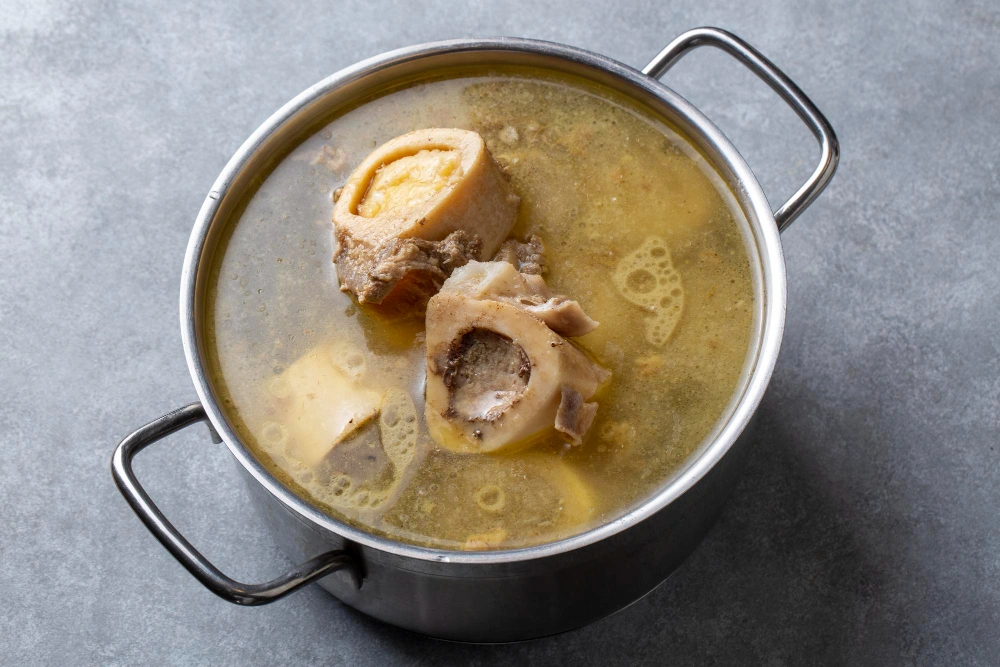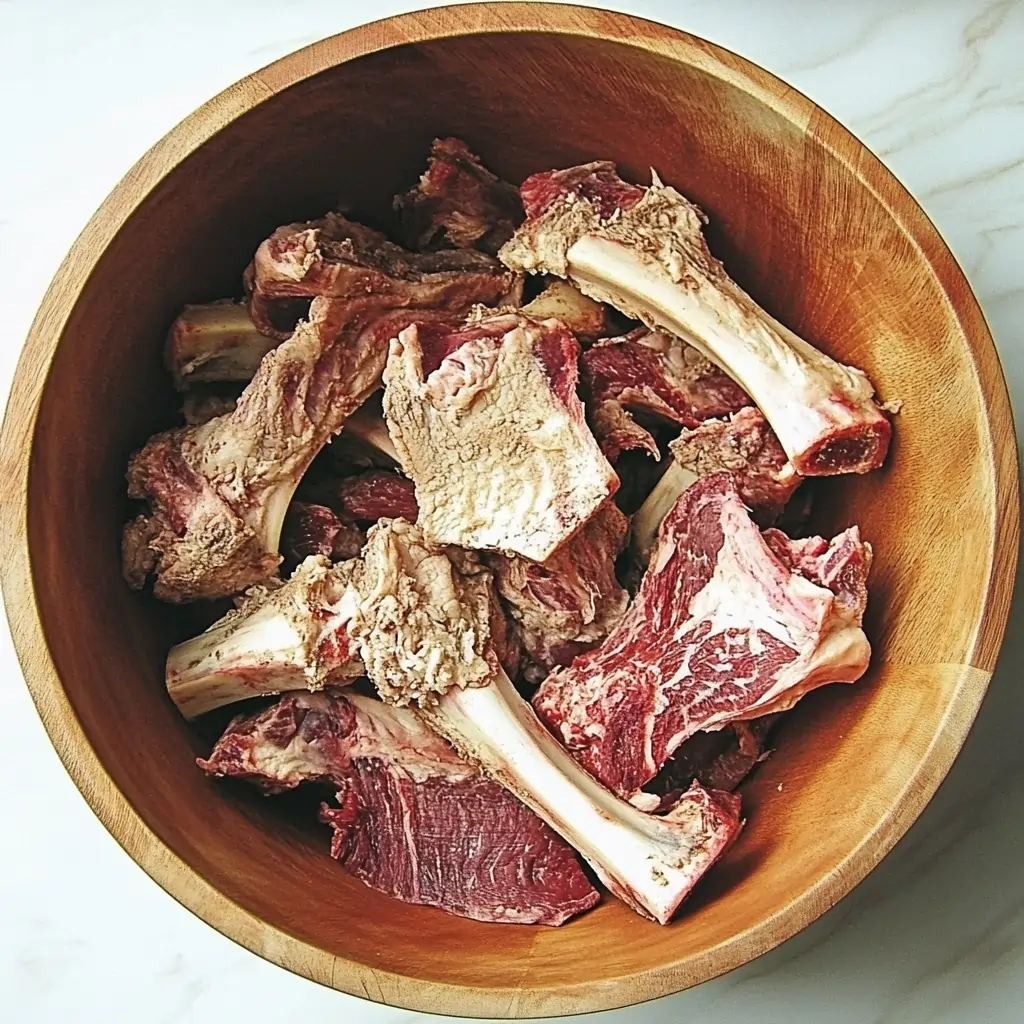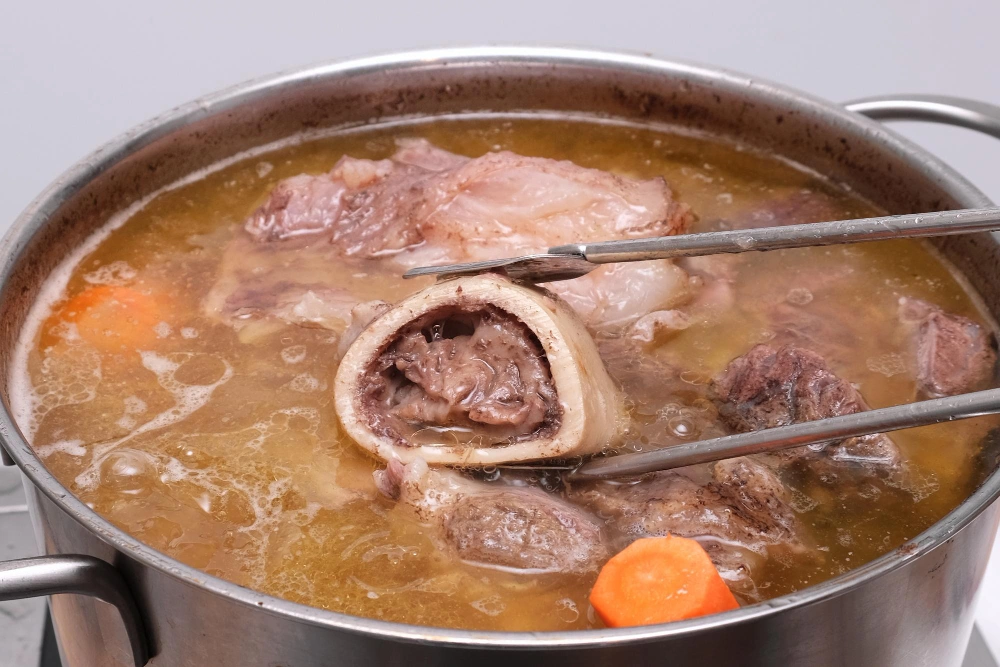Introduction
Soup bones are essential ingredients in creating rich, flavorful broths and soups. These bones, often from beef, or chicken, contain a variety of nutrients and collagen that contribute to a hearty texture and taste. When simmered for an extended period, the bones release minerals, gelatin, and marrow, which enhances the overall flavor profile of your dish.
Moreover, using soup bone allows home cooks to create nourishing meals while making use of cuts of meat that might otherwise go to waste. Consequently, incorporating soup bone into your culinary repertoire not only elevates your dishes but also promotes a more sustainable approach to cooking.

History of Soup Bones
The history of soup bone dates back centuries, deeply rooted in culinary traditions across various cultures. Historically, bones were prized for their ability to impart flavor and nutrition to soups and stews. In fact, many cultures have specific recipes that revolve around the use of soup bone.
For example, in France, the classic pot-au-feu utilizes beef bones to create a comforting stew. In Asian cuisines, bone are often used to prepare ramen and pho, showcasing the versatility of soup bone in different culinary contexts. As time progressed, the understanding of the health benefits associated with soup bone became more pronounced, leading to their resurgence in modern cooking. Today, many home cooks and chefs alike appreciate the depth of flavor and nutrition that soup bons provide.
Nutritional Benefits
The nutritional benefits of soup bone are significant and varied. Firstly, soup bone are an excellent source of collagen, which is essential for maintaining healthy skin, joints, and connective tissues. When bones are simmered, collagen breaks down into gelatin, providing a rich texture to soups.
Furthermore, soup bone are rich in minerals such as calcium, phosphorus, and magnesium, which contribute to bone health. In addition to these nutrients, soup bone are low in calories, making them an excellent addition to a balanced diet. Consuming broth made from soup bone can also aid digestion and contribute to gut health due to its amino acid content. Thus, incorporating soup bone into your meals is a delicious way to boost your nutritional intake.
Bone Broth vs. Soup Bones
While the terms bone broth and soup bone are often used interchangeably, they refer to different concepts. Bone broth is made by simmering bones for an extended period, usually 24 hours or more, to extract maximum flavor and nutrients. This process results in a rich, gelatinous liquid that serves as a base for soups, sauces, or can be consumed on its own.
On the other hand, soup bone refer to the actual bone used in these preparations. While you can use any type of soup bone to create broth, not all bone are suitable for long cooking times. For instance, large beef bones are ideal for making hearty broths, while smaller chicken bones may yield lighter flavors. Understanding the distinction between these two terms can help cooks make informed choices in their culinary endeavors.
How to Select the Best Soup Bones
Selecting the best soup bone is crucial for achieving a flavorful and nutritious broth. When shopping for soup bones, consider the following tips:
- Choose bones with marrow: Marrow bones provide a rich flavor and additional nutrients.
- Look for a variety of bones: Combining different types of bones, such as knuckle, neck, and shank bones, enhances the complexity of the broth.
- Opt for grass-fed or organic: These options often contain higher levels of beneficial nutrients and healthier fats.
- Inspect for freshness: Ensure the bones are fresh, with no off smells or discoloration.
By following these guidelines, you can select the best soup bones to create delicious and nutritious dishes.
Types of Soup Bones
There are several types of soup bones available, each offering distinct flavors and benefits. Common types include:
- Marrow bones: Rich in flavor and nutrients, these bones are perfect for making luxurious broths.
- Knuckle bones: High in collagen, knuckle bones help create a gelatinous texture in soups.
- Neck bones: These bones offer a rich flavor and are often used in traditional recipes.
- Shank bones: Known for their meaty content, shank bones add depth to your broth.
By understanding the various types of soup bones, you can choose the right ones for your culinary needs.
Preparing Soup Bones
Preparing soup bones properly is essential for achieving the best flavor and nutrition. Start by rinsing the bones under cold water to remove any residue. Some cooks recommend roasting the bones in the oven at around 400°F for about 30 minutes before simmering them.
This step enhances the flavor, giving the broth a rich, roasted taste. After roasting, place the bones in a large pot and cover them with cold water. You can also add aromatics such as onions, garlic, and herbs to enhance the flavor profile. Allow the mixture to simmer gently, skimming off any foam that rises to the surface. This process will help clarify the broth and improve its overall quality.
Cooking Methods
There are several cooking methods for preparing soup bones, each offering unique advantages. The most common methods include:
- Stovetop simmering: This method involves simmering bones in a pot of water for several hours. It allows for continuous monitoring and adjusting of flavors.
- Slow cooker: Using a slow cooker is an excellent option for those who want a hands-off approach. Set the cooker on low and let it simmer for 12-24 hours.
- Pressure cooker: A pressure cooker can significantly reduce cooking time, extracting flavors and nutrients in just a few hours.
Choosing the right cooking method depends on your available time and desired flavor intensity. Each approach yields delicious results when using high-quality soup bones.
Popular Recipes
There are numerous recipes that incorporate soup bones, showcasing their versatility in the kitchen. Some popular recipes include:
- Classic beef bone broth: A staple in many households, this recipe uses beef marrow and knuckle bones for a nutrient-dense broth.
- Chicken noodle soup: Utilizing chicken soup bones, this comforting dish is perfect for chilly days.
- Pho: A traditional Vietnamese soup that features beef bones, herbs, and rice noodles.
- Italian wedding soup: This hearty soup combines meatballs, greens, and chicken broth, highlighting the flavor of soup bones.
These recipes demonstrate the adaptability of soup bones, making them a great addition to any meal plan.
Discover more creative ways to use soup bones in the ultimate guide to soup bones, and elevate your cooking with these nutritious ingredients.
Storing and Freezing
Proper storage and freezing techniques can help maximize the usability of soup bones. After using bones to prepare broth, you can store them in an airtight container in the refrigerator for up to three days. If you want to keep them longer, consider freezing them. To freeze soup bones, place them in a freezer-safe bag or container, ensuring you remove as much air as possible.
Soup bones can be stored in the freezer for up to six months. When you’re ready to use them, simply thaw them in the refrigerator or cook them directly from frozen, adjusting cooking times accordingly. This practice allows you to have soup bones readily available for future culinary creations.
Soup Bones and Sustainability
Using soup bones aligns with sustainable cooking practices by promoting the use of whole animals and reducing food waste. By utilizing parts of the animal that are often overlooked, you can create nutritious meals while supporting ethical farming practices. Additionally, making broth from soup bones allows you to extract maximum flavor and nutrition, turning what might be considered scraps into a valuable culinary resource. This sustainable approach not only benefits your health but also contributes to a more environmentally friendly food system.
Encouraging the use of soup bones in everyday cooking can inspire others to adopt similar practices, fostering a culture of sustainability in the kitchen.

Common Mistakes to Avoid
When working with soup bones, it’s essential to avoid certain common mistakes that can affect the outcome of your dish. Some common pitfalls include:
- Not simmering long enough: Insufficient cooking time can result in a broth that lacks flavor and nutrients. Aim for at least 6-8 hours for optimal results.
- Using poor-quality bones: Selecting bones from unhealthy animals can lead to inferior broth. Always choose high-quality, organic options when possible.
- Overcrowding the pot: If the pot is too full, the bones may not simmer properly. Ensure there’s enough space for the broth to circulate.
- Neglecting to skim foam: Skimming the foam that forms on the surface can help clarify the broth and improve its flavor.
By avoiding these common mistakes, you can create delicious and nutritious meals using soup bones.
FAQ’s
What is a soup bone?
A soup bone is a type of bone, often from animals like beef, or chicken, that is used as a key ingredient in making broth or soup. These bones are typically simmered for an extended period, allowing the flavors and nutrients to be extracted, resulting in a rich and hearty liquid. Soup bones may include marrow bones, knuckle bones, and other types that contribute to a flavorful and nutritious base for various dishes.
What is a soup bone slang?
In slang terms, a soup bone can refer to a person who is perceived as being weak or lacking in substance. This usage is often informal and can vary in connotation depending on the context. It is important to consider the tone and situation when using slang terms, as they can be interpreted in different ways.
Are soup bones good to eat?
Yes, soup bones can be quite nutritious and flavorful. When prepared properly, the broth made from soup bones is rich in collagen, minerals, and other essential nutrients. Additionally, the marrow found in certain bones adds depth of flavor and beneficial fats. While the bones themselves are not typically consumed, the broth they produce can be a healthy addition to soups, stews, and sauces, providing numerous health benefits.
What bones are used in soup?
Various types of bones can be used in soup, including:
- Marrow bones: These bones contain rich marrow that adds flavor and nutrients to the broth.
- Knuckle bones: High in collagen, they help create a gelatinous texture in soups.
- Neck bones: These provide a robust flavor and can be used in traditional recipes.
- Shank bones: Known for their meatiness, shank bones add depth and richness to the broth.
Using a combination of these bones can enhance the overall flavor and nutritional content of your soup.
Conclusion
In conclusion, soup bones are a versatile and nutritious ingredient that can elevate your culinary creations. Understanding their history, nutritional benefits, and preparation methods can help you make the most out of this valuable resource.
By selecting the right types of soup bones, preparing them properly, and avoiding common mistakes, you can create flavorful broths and soups that nourish both body and soul. Additionally, embracing the use of soup bones promotes sustainability in cooking, allowing you to make the most of every ingredient.
Ultimately, incorporating soup bones into your recipes not only enhances flavor but also contributes to a more responsible and enjoyable cooking experience.


3 thoughts on “Soup Bones: The Ultimate Guide to Benefits, Recipes, and More”